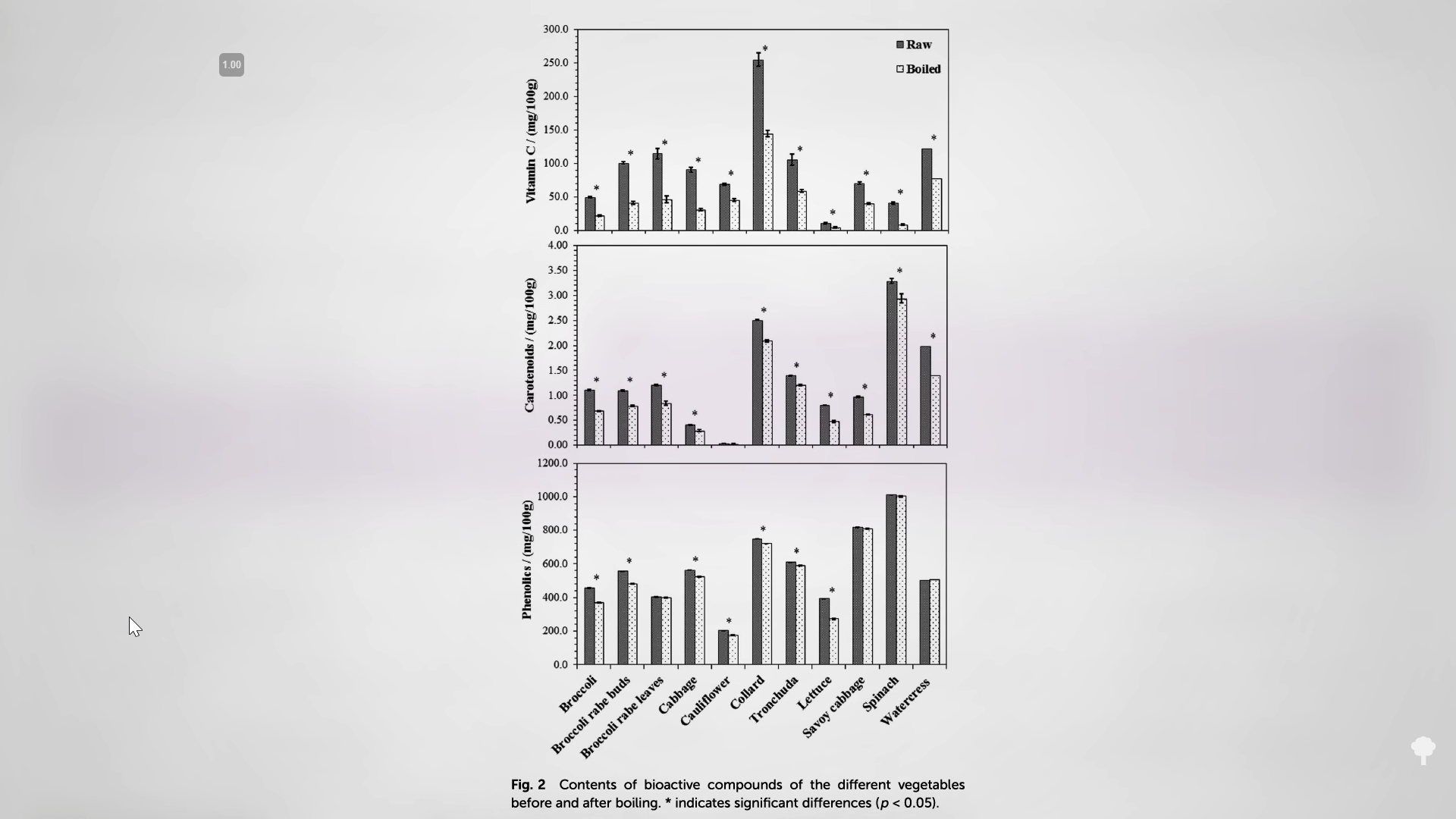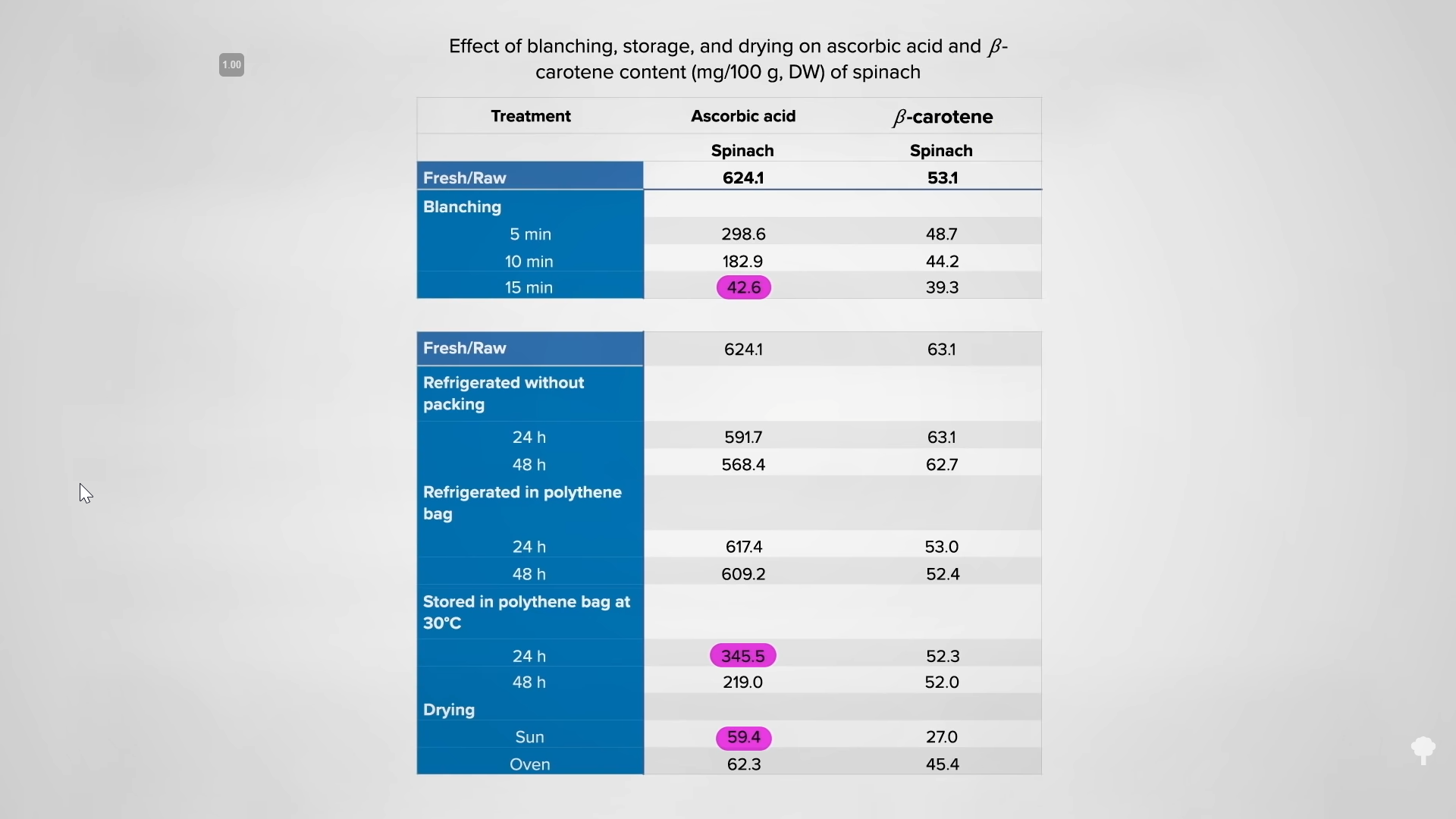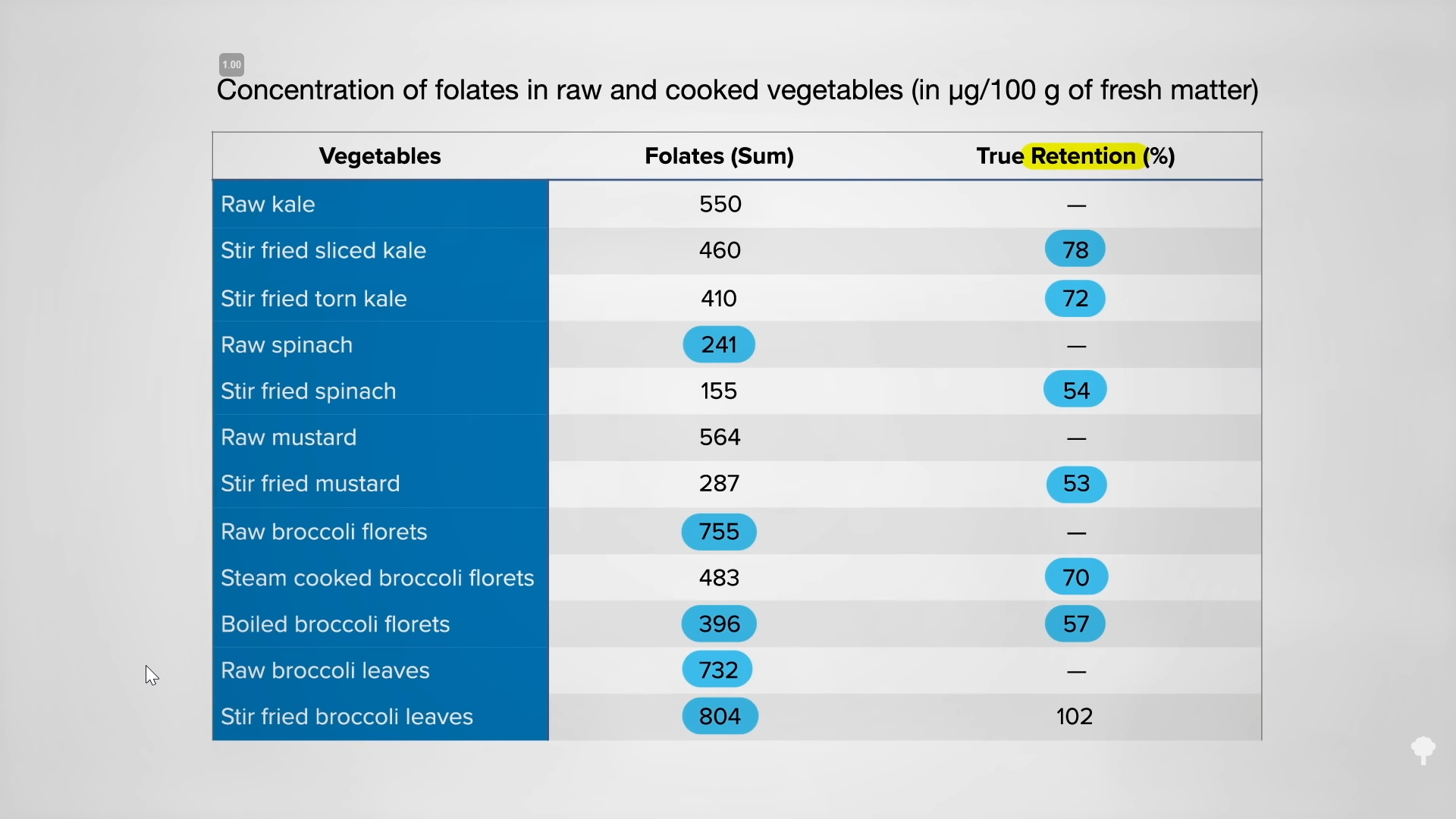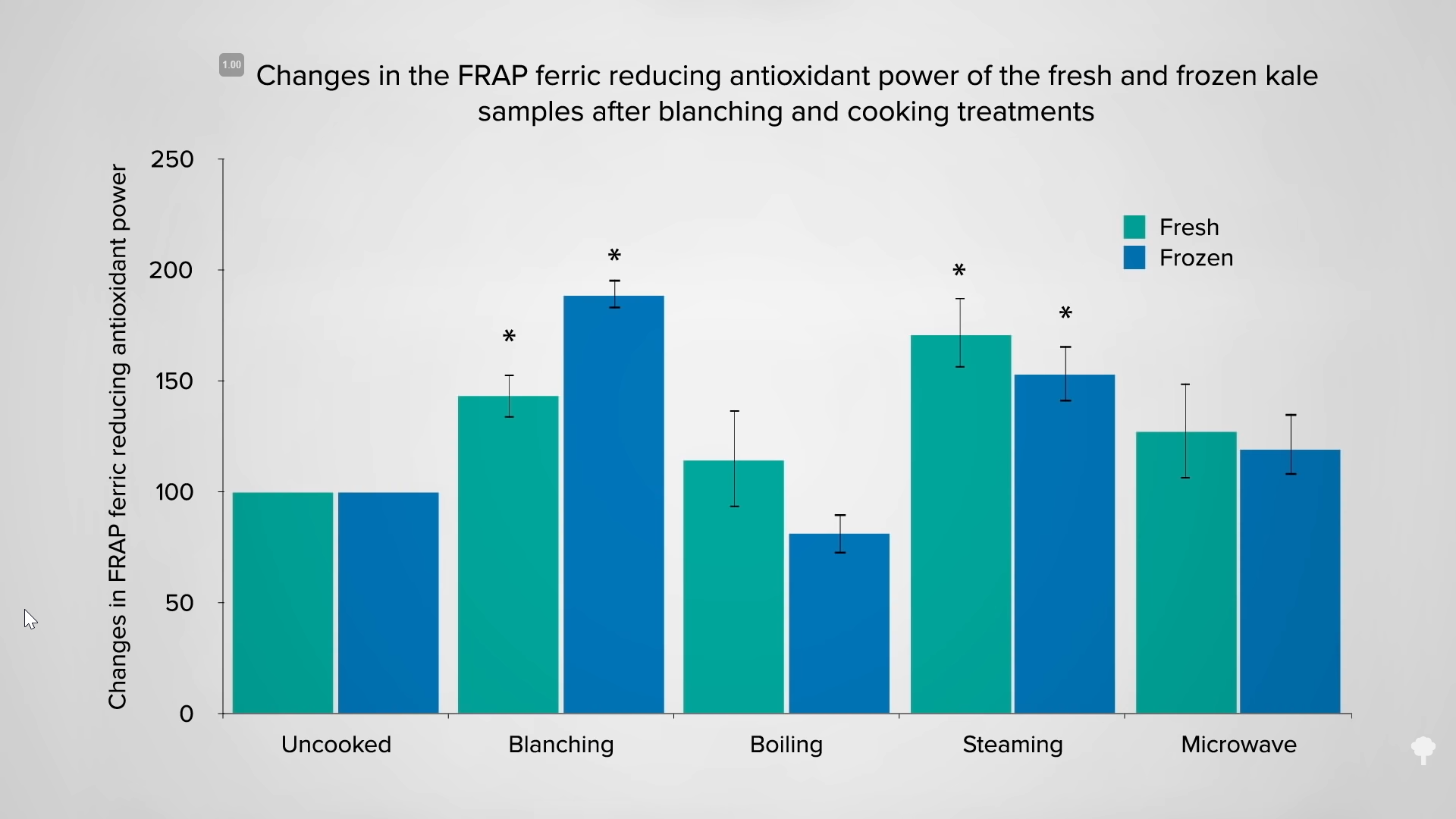The Best Way to Cook Greens

What is the best way to prepare dark green leafy vegetables, the most nutrient-dense foods on the planet?
“The main purpose of cooking is to make vegetables more edible, palatable, and digestible…The downside is that cooking may adversely affect the levels of nutrients and bioactive compounds, especially the heat-sensitive and water-soluble ones.” But, as you can see in the graph below and at 0:19 in my video Flashback Friday: How to Cook Greens, even if you boil greens for ten minutes, the drop in antioxidant capacity, which is a rough proxy for phytonutrient retention, isn’t that much. Yes, there’s a significant 15 to 20 percent drop in each case, but most of the antioxidant power is retained. The single nutrient that drops the most is probably vitamin C, but data show that collard greens start out so rich in vitamin C that even when they’re boiled for ten minutes, they have twice as much vitamin C as raw broccoli.

However, the vitamin C in spinach really takes a hit during cooking. Even blanching for just five minutes can cut vitamin C levels by more than half, with more than 90 percent dissolving into the water after 15 minutes, as you can see below and at 0:58 in my video. Most of the beta-carotene, which is fat soluble, tends to stay in the leaves, though. Keeping spinach in a regular plastic bag (like you may find in the produce aisle at your local market) can protect it. Refrigeration is important, too. Even when stored in a bag, a hot day can wipe out nearly 50 percent of the vitamin C in spinach. Drying is especially damaging, eliminating up to 90 percent of the vitamin C, which suggests that kale chips may pale in comparison to fresh kale. Vitamin C is particularly sensitive, whereas other nutrients, like beta-carotene, are less affected across the board.

Microwaving and steaming watercress, for example, preserve more nutrients than boiling does. As you can see in the graph below and at 1:42 in my video, steaming or microwaving has little impact when compared to raw, though boiling for even two minutes may cut antioxidant levels nearly in half. Watercress is a cruciferous vegetable, a member of the cabbage and broccoli family, so it’s prized for its glucosinolate, which turns into the magical compound sulforaphane. What does cooking do to glucosinolate levels? As you can see below and at 2:06 in my video, while fresh is best, the data show that steaming has the least impact, microwaving comes in second, and stir-frying and boiling result in the most significant loss. The glucosinolates in other cruciferous vegetables are also significantly affected by boiling. Researchers have concluded that red cabbage is best consumed fresh. As I shared in my book How Not to Die, I always keep a red or purple cabbage in my crisper to cruciferize my meals, slicing off shreds and putting them on basically anything and everything. But if you are going to cook it, steaming may be the best bet “so as to retain the optimum benefits of the health-promoting compounds.”

Other nutrients we look to greens for are eyesight-preserving nutrients like lutein and folate. Folate is particularly important for women of childbearing age, and vegetables are the main natural source. It’s been estimated that approximately half of the folate is lost during cooking, which may be true for boiling broccoli or stir-frying spinach or mustard greens, as you can see below and at 3:01 in my video. But, the folate in stir-fried kale holds up better, only losing about a quarter, similar to steamed broccoli florets. However, broccoli starts out so high in folate that even boiled broccoli has more folate than raw spinach. Broccoli leaves are an interesting case: Not only do they start out with among the highest levels of folate, but their levels actually go up a bit when you cook them. Prior to this study, no one had ever looked at the folate concentration in broccoli leaves. They’re commonly just cut off and thrown away, but since they contribute “great concentrations of this vitamin,” we should make sure to eat them.

Researchers also compared thinly sliced kale to kale torn into larger pieces to determine if a larger surface area of exposure would promote greater losses of folate, but no effects were found, so slice away. This study just looked at stir-frying, though. What about the effect of other cooking methods on kale? There have been many studies on cooking cabbage and broccoli; however, very little information has been available on the “queen of greens”—until recently.
First of all, the study compared fresh versus frozen. “The freezing process is generally regarded as destructive to antioxidant compounds. Frozen samples are assumed to have a lower antioxidant capacity compared to fresh ones,” but kale breaks all of the rules. The frozen kale showed 60 percent more antioxidant capacity than fresh! But what happens when you cook it? As you can see in the graph below and at 4:43 in my video, if you normalize the starting levels at 100 percent, blanching and steaming actually boost the antioxidant content, whereas microwaving or even boiling doesn’t have much negative impact. Therefore, you can boil kale without losing its antioxidant punch. I told you kale’s a rule breaker!

The heat associated with blanching and steaming can disrupt the plant cell walls and all of the little subcellular compartments and spill out extra antioxidant compounds that may have been hiding. Now that’s usually counterbalanced by losses caused by high temperatures, but the kale compounds look pretty cruciferocious by standing their ground.
I often get questions about how to prepare certain foods to maximize their benefits, so I love it when I can bring you videos like this one and Flashback Friday: Best Way to Cook Vegetables. For more on optimum cooking methods and why it’s so important to eat greens every day, check the Related Videos below.
If you have any concerns with microwaving, you may find my video Flashback Friday: Are Microwaves Safe? & The Effects of Radiation Leaking from Microwave Ovens informative.
If you eat multiple cups of dark green leafy vegetables a day—as I hope we all do—it’s probably best to stick to low-oxalate ones to avoid the risk of kidney stones. Low-oxalate greens are basically any greens other than spinach, swiss chard, and beet greens. See my video Kidney Stones and Spinach, Chard, and Beet Greens: Don’t Eat Too Much to learn more.
What about pressure cooking? (I’m looking at your Instant Pot.) Does Pressure Cooking Preserve Nutrients?

